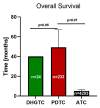Aggressive Thyroid Carcinomas Clinical and Molecular Features: A Systematic Review
- PMID: 40564998
- PMCID: PMC12192656
- DOI: 10.3390/ijms26125535
Aggressive Thyroid Carcinomas Clinical and Molecular Features: A Systematic Review
Abstract
Aggressive thyroid carcinomas are rare malignancies characterized by a high impact on patient's lives and poor prognosis. The available literature is scarce presenting divergent data concerning the clinical outcomes, prognostic factors and variable mutational signature studies. We aim to collect data from the literature and assemble a systematic review. The literature from 2007 until May 2025 was searched using PubMed. Studies bearing data concerning clinical aspects, prognostic outcomes, or molecular characteristics of differentiated high-grade (DHGTC), poorly differentiated (PDTC), and anaplastic thyroid carcinomas (ATC) were retrieved. Original articles in English, ethically conducted on human patients, were selected. From 688 articles, 39 were included. DHGTC has a good 5-year survival rate (5YSR) of 76%, 23.18% metastasis rate, 42.23%, lymph node involvement (LNI), 61.44% extrathyroidal extension (ETE), majority being diagnosed in stage III. PDTC has an intermediate 5YSR of 65.71%, 21.17% distant metastasis, 32.22% LNI, and 55.19% ETE, majority diagnosed in stage III. ATC has a grim 2-year survival rate of 11.15%, 42.15% metastasis, 44.14%, LNI, and 58.51% ETE, majority presented in stage IV-B. Mutational profiling shows that each carcinoma has its unique set of molecular alterations. Most positive prognostic comes for DHGTC, then PDTC, and finally, ATC.
Keywords: ATC; DHGTC; PDTC; aggressive; anaplastic; differentiated high grade; poorly differentiated; thyroid carcinoma.
Conflict of interest statement
The authors declare no conflicts of interest.
Figures





Similar articles
-
Comparative analysis of follicular cell- derived thyroid carcinoma: assessing the impact of high-grade features in an advanced disease cohort.Virchows Arch. 2025 Jun;486(6):1305-1315. doi: 10.1007/s00428-025-04109-2. Epub 2025 May 2. Virchows Arch. 2025. PMID: 40312532 Free PMC article.
-
[18F]-FDG Uptake as a Marker of Residual Anaplastic and Poorly Differentiated Thyroid Carcinoma following BRAF-Targeted Therapy.AJNR Am J Neuroradiol. 2025 Jun 3;46(6):1260-1267. doi: 10.3174/ajnr.A8588. AJNR Am J Neuroradiol. 2025. PMID: 39572200
-
BRAF mutation in papillary thyroid cancer and its value in tailoring initial treatment: a systematic review and meta-analysis.Medicine (Baltimore). 2012 Sep;91(5):274-286. doi: 10.1097/MD.0b013e31826a9c71. Medicine (Baltimore). 2012. PMID: 22932786
-
Cost-effectiveness of using prognostic information to select women with breast cancer for adjuvant systemic therapy.Health Technol Assess. 2006 Sep;10(34):iii-iv, ix-xi, 1-204. doi: 10.3310/hta10340. Health Technol Assess. 2006. PMID: 16959170
-
Evaluation of PD-L1, TERT promoter mutations, and BRAFV600E mutation in poorly differentiated, differentiated high grade thyroid carcinoma and anaplastic carcinoma of the thyroid: our institutional experience.Virchows Arch. 2025 Jun 7. doi: 10.1007/s00428-025-04134-1. Online ahead of print. Virchows Arch. 2025. PMID: 40481961
References
-
- Ferlay J., Ervik M., Lam F., Laversanne M., Colombet M., Mery L., Piñeros M., Znaor A., Soerjomataram I., Bray F. Global Cancer Observatory: Cancer Today. International Agency for Research on Cancer; Lyon, France: 2024.
-
- Li M., Meheus F., Polazzi S., Delafosse P., Borson-Chazot F., Seigneurin A., Simon R., Combes J.-D., Maso L.D., Colonna M., et al. The Economic Cost of Thyroid Cancer in France and the Corresponding Share Associated with Treatment of Overdiagnosed Cases. Value Health. 2023;26:1175–1182. doi: 10.1016/j.jval.2023.02.016. - DOI - PubMed
-
- WHO Classification of Tumours Editorial Board . Endocrine and Neuroendocrine Tumours [Internet] 5th ed. Volume 10 International Agency for Research on Cancer; Lyon, France: 2022.
Publication types
MeSH terms
Substances
Grants and funding
LinkOut - more resources
Full Text Sources
Medical
Research Materials

